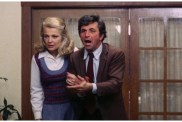A look at the groundbreaking and harrowing 1955 addiction drama The Man with the Golden Arm
I remember when Darren Aronofsky was doing the press tour for his controversial and unsparing 2000 Hubert Selby Jr. adaptation Requiem for a Dream, he correctly cited the film as a horror movie, one in which the monster was the heroin that seduced, dominated and decimated the lives of its fragile, deluded blue-collar characters. That’s kind of Selby Jr.’s beat, sifting through the streets and trying to find grace notes among the desperate, scrambling human beings who are forever lost to boredom, poverty and vice. But in Aronofsky’s film, the idea of addiction is pumped up to supernatural heights, with screeching Clint Mansell music, rapid fire visuals, extreme sexual debasement and carnivorous refrigerators. Yeah, it’s a horror movie alright and one that no one who has endured it ever manages to forget.
But long before Aronofsky attacked audiences with Requeim, director Otto Preminger broke ground with another film about a junkie perpetually trying to outsmart the drooling monkey that claws at his back, 1955’s The Man With the Golden Arm , based on the novel by Nelson Algren. Starring iconic crooner and occasional actor Frank Sinatra in what is most assuredly his greatest performance, Man is a film crawling out the sensibilities of the morally ambiguous and unofficial noir subgenre of the 1940s but bleeding into more dangerous, graphic territory, rejecting as it did the dying Production Code that had been sanctimoniously clipping Hollywood’s balls since the early 1930s. But Preminger was adamant that his movie did not glamorize drugs rather it showed the smack as life-decimating parasite that, once invited into its host’s life, refused to vacate until that person was dead. Preminger and distributor United Artists released the movie without the approval of the MPAA and, though their battle was hard won, their defiance was instrumental in paving the way for a new wave of American cinema that would eventually reform and dominate American cinema in the 1960s.
The movie does indeed star Sinatra as the kindly but deeply troubled Frankie Machine, a junkie card dealer from the slums of Chicago who, as the film opens (after a blistering Saul Bass-designed credits sequence with a screaming, horn-heavy Elmer Bernstein theme), has just been released from jail after taking the rap for the local card shark’s after hours and illicit gambling racket. Frankie has, with the aid of a prison doctor, kicked his all-consuming heroin habit and has even learned how to play drums while in the slammer. Back on the streets with a drum kit and dreams of a new life, free of smack and hopefully making music professionally, Frankie is almost immediately sucked back into the Hell that refuses to let him leave. As he drifts into the local bar to see his sweet, nickel and dime hustler pal Sparrow (turtle-faced comedian Arnold Stang, who famously was the voice of cartoon character Top Cat), the leering gaze of drug peddling pimp Nifty Louie (The Night Stalker and A Christmas Story‘s Darren McGavin in his most reptilian performance) locks on him instantly, sliming around his now healthy former customer/slave and trying to get him to “come across the street”, to the flophouse where the dandy slug brings all of his willing victims.

But Frankie refuses. He wants to stay straight. To make something of himself, despite the people from way back who surround him, people he desperately wants to leave way back but financially, sadly, is yet unable to. But potentially worse than the lure of Nifty Louie, nor the call of the seedy card dens and their offer of easy dough and quick fixes, is Frankie’s toxically needy wife Zosh (Elanor Parker), a paraplegic who uses her disability and host of other ailments bot real and imagined to manipulate and control her long-suffering husband and is especially threatened by Molly, the pretty blonde who lives downstairs. Played by future Vertigo star Kim Novak, Molly is Frankie’s angel, a woman who it is implied that Frankie has had an affair with during his darker days and who clearly is deeply, profoundly in love with the man and who believes in him. He loves her too and wants nothing more than to whisk her away from their shared greasy existence. But his guilt over his wife keeps him chained to his old life and soon, when the tensions around him once more boil over, re-ignites his need for the needle. Nifty Louie moves in and obliges, jamming his poison into Frankie’s vein and starting the cycle of misery all over again. And when things start to get good for Frankie and his dreams start to fall into place, the vampires of his past refuse to allow the light to shine on the man.
Filmed almost like a stage play on shadowy, wonderfully lurid, neon and filth soaked sets and brilliantly performed by the entire cast, the literate and urgent The Man With the Golden Arm (the title refers to Frankie’s skill as a card dealer, his ambitions with the drums and his often punctured limb that serves as a cash cow for all the smack-peddlers that profit off it) is, like Requiem for a Dream was 45 years later, an urban horror film, a choking nightmare that paints an ugly, terrifying portrait of just how chained people can become to bad habits and bad people. This movie feels unhealthy and though contemporary audiences may find some of the performances too broad (McGavin’s smack dealer is often almost Snidely Whiplash-esque), they have to be to serve both the story and Preminger’s chosen aesthetic . Like Requiem, the drama is pushed past the point of good taste to help sculpt the concrete Boschian Hell where these sad characters dwell. And Bernstein’s unyielding evil jazz music pounds it all into a frantic, queasy paste.
Sinatra’s Frankie is a tragic figure but so are all the broken men and women who shuffle around Preminger’s bleak canvas, lost as they are and desperately searching for some way out. Even Zosh, manipulative and dangerous as she is, is not evil. Nor is Nifty Louie, either. They are all just shadows on mirrors, victims of bad breeding, bad choices and bad luck, trapped in a vicious cycle of cheap living and pointless death, none of them leaving anything resembling a legacy. Even now, after Requiem and so many other ruthless, horrific portraits of addiction on screen, The Man With the Golden Arm has a primal power and a message that is timeless. See it immediately.









